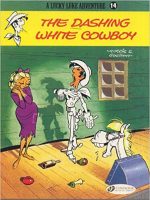
By Morris & Goscinny, translated by Frederick W. Nolan & Simone Kunzig (Cinebook)
ISBN: 978-1-905460-66-3
Rangy, good-natured Lucky Luke is a doughty cowboy able to “draw faster than his own shadowâ€, amiably roaming the fabulously mythic Old West, enjoying light-hearted adventures on his rather sarcastic know-it-all wonder-horse Jolly Jumper. He constantly interacts with a host of historical and legendary figures as well as even odder folk…
His unceasing exploits over 70 years have made him one of the best-selling comic characters in Europe – if not the world – generating in excess of 83 individual albums, sales totalling in excess of 300 million in 30 languages… so far…
That renown has generated the usual mountain of spin-off toys, computer games, animated cartoons and a plethora of TV shows and live-action movies.
First seen in the 1947 Annual (L’Almanach Spirou 1947) of Le Journal de Spirou, Lucky was created in 1946 by Belgian animator, illustrator and cartoonist Maurice de Bévère (“Morrisâ€), before ambling into his first weekly adventure ‘Arizona 1880’ on December 7th 1946.
Working solo until 1955, Morris produced nine albums of affectionate sagebrush spoofery before teaming with old pal and fellow trans-American tourist Rene Goscinny, who became regular wordsmith as Luke attained the dizzying, legendary, heights starting with ‘Des rails sur la Prairie’ (Rails on the Prairie), which began serialisation in Spirou on August 25th 1955.
In 1967, the six-gun straight-shooter switched sides, joining Goscinny’s own magazine Pilote with ‘La Diligence’ (The Stagecoach). Goscinny co-created 45 albums with Morris before his untimely death, from whence Morris soldiered on both singly and with fresh collaborators.
Morris died in 2001, having drawn fully 70 adventures, plus numerous spin-off sagas crafted with Achdé, Laurent Gerra, Benacquista & Pennac, Xavier Fauche, Jean Léturgie, Jacques Pessis and others, all taking their own shot at the venerable vigilante…
Lucky Luke has previous in this country too, having first pseudonymously amused and enthralled British readers during the late 1950s, syndicated to weekly anthology Film Fun. He later rode back into comics-town in 1967 for comedy weekly Giggle, where he used the nom de plume Buck Bingo.
In all these venues – as well as many attempts to follow the English-language album successes of Tintin and Asterix – Luke laconically puffed a trademark cigarette which hung insouciantly and almost permanently from his lip. However, in 1983 Morris – amidst pained howls and muted mutterings of “political correctness gone mad†– deftly substituted a piece of straw for the much-travelled dog-end, thereby garnering for himself an official tip of the hat from the World Health Organization.
The most successful attempt to bring Lucky Luke to our shores and shelves comes from Cinebook (who rightly restored the foul weed to his lips on the interior pages, if not the covers…), and it’s clearly no big deal for today’s readership as we’re at 69 translated books and still going strong.
As Le Cavalier Blanc The Dashing White Cowboy was Morris & Goscinny’s 33rd collaboration, originally serialised in 1974 (and the hero’s 43rd album release a year later): a brash and engaging comedy of errors with the laconic freelance lawman encountering cunning bandits with a seemingly unbeatable modus operandi…
In the desolate wilds between frontier towns Luke and Jolly Jumper cross trails with a small but determined travelling troupe. The merry band consists of actor/impresario Whittaker Baltimore and his repertory company of the range: ingenue/leading lady Gladys Whimple, character (villain) player Barnaby Float and props man, set shifter and applause-starter Francis Lusty.
An affably welcoming bunch, they gift the wanderer with a complimentary ticket for their next performance in the nearby town of Nothing Gulch…
Following a sardonic and satirical aside describing the nature of theatrical entertainment at this time and place, the story resumes with that much-anticipated melodrama “The Dashing White Cowboy†before the rowdy a not-particularly-au-fait Nothing Gulch crowd hungry for a break from everyday monotony.
Also eagerly lapping up the raucous entertainment are Luke and good friend Hank Wallace, but the boisterous audience participation turns ugly after a horrified cry of “The bank’s been robbed!†starts a riot…
Despite Lucky’s best efforts, the crime goes unsolved and soon after the motley crew up stakes for the next town. Coincidentally Miner’s Pass is Luke’s next port of call, too. At least it is now…
When the same performance is identically disrupted, the coincidence is too much to swallow… and then Luke – present at both crimes – is accused of robbery!
Barely escaping being lynched, our hero sets off after the Whittaker Company, Catching up to them in Indian Flats, he joins the cast, but when another bold theft occurs, he is once again the prime suspect…
By the time he gets out of jail, the trail has gone cold. Can it be that he has at last met his match?
Of course not, and, following a fortuitous break, the vengeance of the affronted justice-rider finally falls upon the deserving party… or is that parties?
Wry and devious, The Dashing White Cowboy is a fast-paced slapstick romp with plenty of action, vaudevillian chicanery, dirty double-dealing and barrel-loads of hilarious buffoonery. Superbly crafted by comics masters, this performance affords another enticing glimpse into a unique genre for today’s readers who might well have missed the romantic allure of an all-pervasive Wild West that never was…
© Dargaud Editeur Paris 1975 by Goscinny & Morris. © Lucky Comics. English translation © 2008 Cinebook Ltd.
